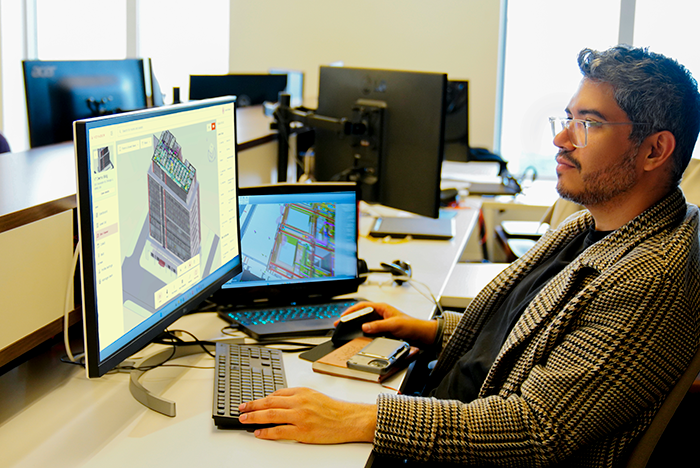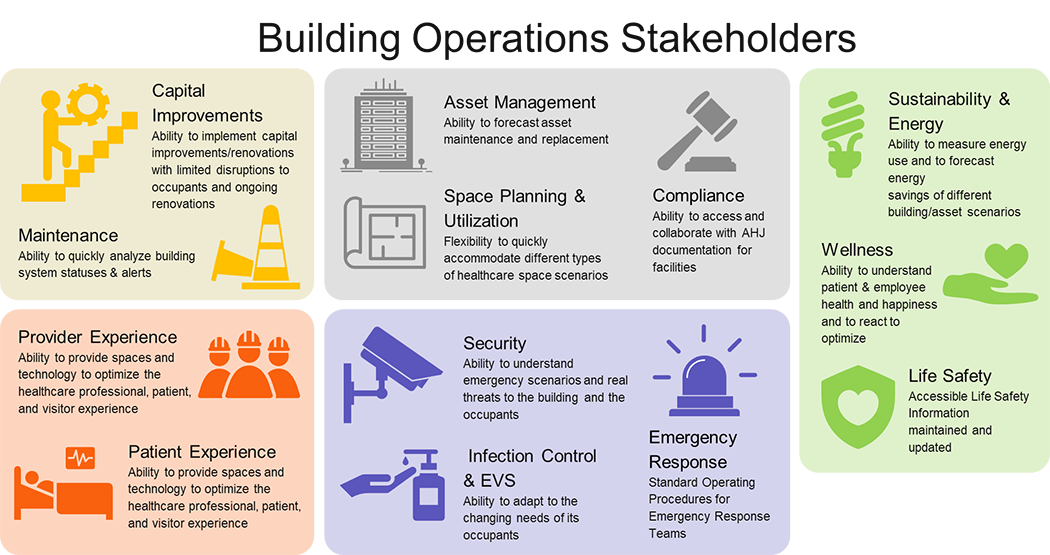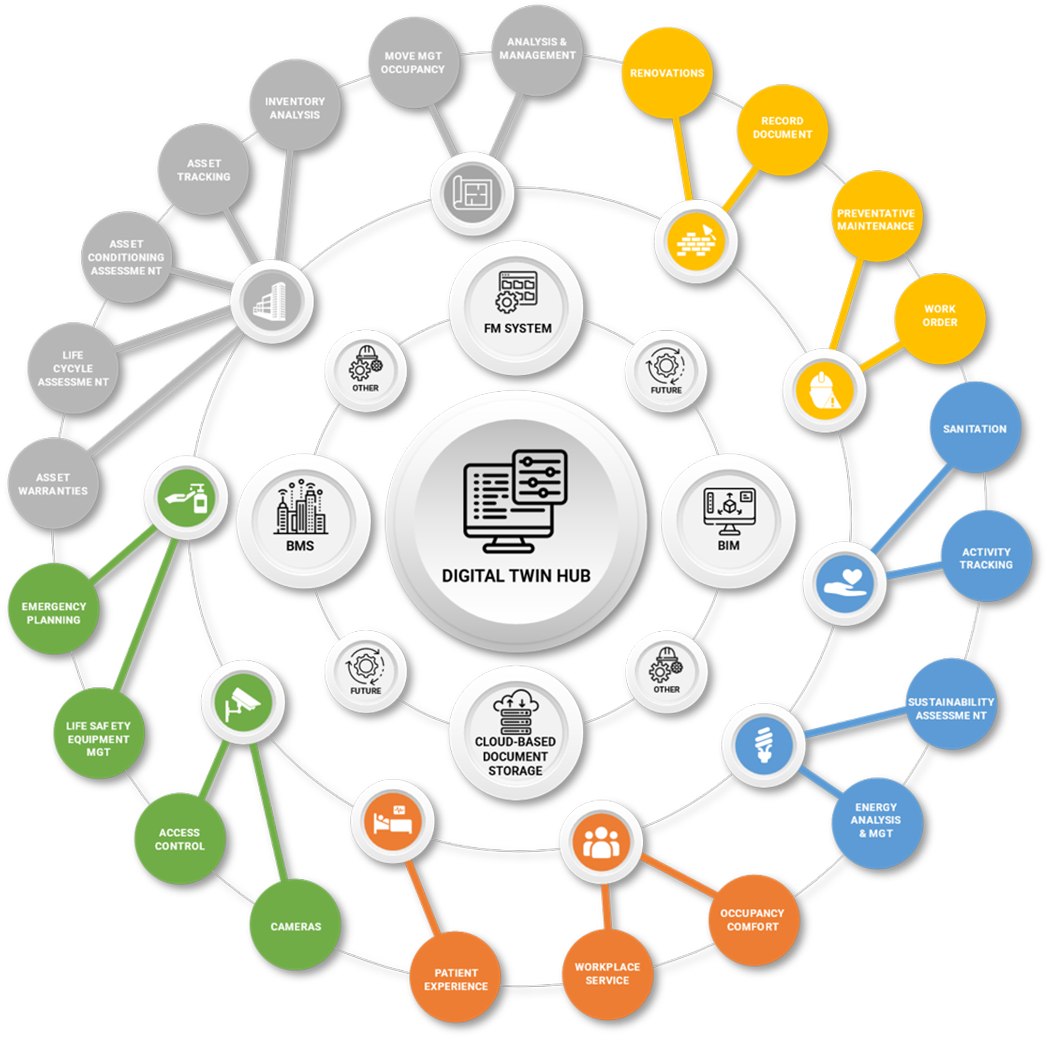The value of digital twins
About this series: “Digital Twins” is a three-part series that introduces health care facilities managers to the world of digital twins. It offers a clear and practical overview of what digital twins are; the specific value they bring to health care; the role of planning, design and construction (PDC) in their implementation; and how to get started.
This first article offers facilities managers a general introduction to digital twins, including a basic definition, their intended audiences and key use cases. Subsequent articles will explore the value of digital twin data in construction handovers and delve deeper into the unique benefits digital twins provide to health care facilities.

Digital twins help to bridge the gap between design and construction, and daily operations.
Image courtesy of VIATechnik
Facilities managers are adaptable problem solvers, often referred to as a “rare breed” because, as the saying goes, “No two days are the same.” In mission-critical environments such as health care, the demands placed on facilities managers require an even rarer level of skill and dedication. Once a health care site becomes operational, the facilities manager assumes full responsibility for its performance. There are no excuses. Regardless of unfinished punch list items, missing record drawings or incomplete equipment information, the facility must function as expected because the lives of patients depend on it.
Adding to this challenge is the diverse range of stakeholders health care facilities managers must satisfy. These stakeholders include end-users, staff and, most critically, patients — each with unique expectations and concerns about the facility’s performance.
Health care facilities are high-stakes, dynamic environments, underscoring the need for continuous improvement in the areas of people, processes and technology. To meet these challenges, health care facilities managers must consistently seek advancements that enhance patient care, optimize end-user satisfaction and improve overall building performance.
What is a digital twin?
Digital twins have created a tidal wave of buzz in recent years. Although they have been successfully used in various industries, their application for facilities managers — especially health care facilities managers — is distinct and requires a tailored approach. For the built environment, the definition of a digital twin is:
A digital representation of a physical environment, enabling data-driven insights and action.
It represents a connection between the digital and physical world, and it is used to enable organizations to monitor, analyze and simulate real-world data in a virtual environment.
At its core, a digital twin aggregates data from multiple sources to provide actionable insights and support informed decision-making. The true power of a digital twin lies in its ability to create a centralized access point where stakeholders can access, interpret and act on data. This connectivity transforms raw data into meaningful insights, driving measurable improvements in operations, performance and outcomes.
For health care facilities managers, this means unlocking the potential of their facilities’ data to optimize performance, improve stakeholder satisfaction and ultimately enhance patient care.
Square peg, round hole
The architecture, engineering and construction industry faces an ongoing challenge: the assumption that technologies used during the design and construction phases will seamlessly carry over to the operations phase of a building’s life cycle.
A prominent example is building information modeling (BIM), which has become a powerful tool and the professional standard for design and construction. Over the past decade, BIM has been widely recognized for its transformative potential in building operations. However, its full capabilities and benefits have yet to be fully realized in practice, leaving opportunities for further growth and refinement.
This mismatch often results in a "square peg, round hole" issue, where technology designed for one purpose fails to meet the fundamentally different needs of building operations.
The root of this issue isn’t technology; It’s a human problem. The opportunity lies in truly listening to and understanding the specific needs and challenges of building operations, rather than dictating what technologies should be used. When the tools that solved problems during design and construction are applied without adaptation to operations, they often fall short of addressing the facilities manager’s or chief financial officer’s unique concerns. This mismatch can breed distrust in technology, as it appears incapable of solving operational challenges.
However, this misalignment shouldn’t discourage the use of technology. Instead, it should be seen as an opportunity to engage with building operations teams, define their specific problems and identify which technologies or components of those technologies can genuinely optimize workflows and address pain points.
Revisiting the "square peg" analogy, perhaps the solution isn’t to force the entire square peg into the round hole but to refine it, delivering only the parts that are relevant and adaptable. By tailoring technology to fit operational needs, the field can bridge the gap between design, construction and operations, fostering trust and delivering meaningful value.
Value proposition through stakeholders
While health care facilities managers face unique challenges in their day-to-day operations, they are ultimately responsible for the performance of their facilities and the impact of those facilities on daily operations. This responsibility underscores the fact that digital transformation and the application of digital twins in building operations cannot stop at addressing the immediate problems faced by the facilities team. Instead, it must extend to understanding how these tools and processes can also help stakeholders, end-users and patients solve their challenges.
The value of a digital twin increases significantly when stakeholders are actively identified and engaged to define use cases. By involving these diverse groups in strategy sessions, facilities managers can uncover insights that lead to alignment between various stakeholders. This collaborative approach ensures that digital twins are tailored to meet the needs of all client types, driving meaningful improvements in building performance and the overall experience for everyone involved.
Commonly recognized stakeholder groups, such as capital projects, maintenance and asset management departments, are often the focus when considering digital twins. However, the applications and value of digital twins extend far beyond these areas. The definition of "stakeholders" can vary by context, but in health care facilities management, stakeholders typically include departments or groups responsible for supporting building operations. By engaging with primary stakeholders within the facilities team, organizations can identify key contributors and progressively expand the stakeholder network as new use cases emerge.
This iterative approach ensures that digital twin initiatives remain aligned with the needs of the facility while fostering greater collaboration and buy-in across the organization. Over time, this process not only strengthens the adoption of digital twin technology but also broadens its impact across diverse operational and strategic objectives.
A list of health care organization stakeholders that could benefit from digital twins are detailed in the graphic below:
Building a case
Defining use cases for stakeholders begins with one essential action: listening. Through ongoing conversations and stakeholder engagement, areas where digital twins can bring value and optimization to facilities departments are revealed. In health care, typical use cases often align with key stakeholder needs, such as:
Asset identification, location and performance analysis
Digital twins enable virtual identification of asset locations, providing technicians with critical information before performing maintenance. Beyond this, digital twins can analyze cross-referenced data from the facility’s building management system (BMS) and computerized maintenance management system (CMMS).
For example, if an asset frequently requires maintenance after its temperature exceeds 85 degrees, the digital twin can detect this trend by correlating maintenance data from the CMMS with temperature readings from the BMS. This insight allows proactive measures to prevent future failures and improve the asset management department’s processes and workflows.
Sustainability and energy
Hospitals are increasingly required to meet stringent energy-consumption requirements as part of evolving energy regulations. A digital twin can integrate with these benchmarks, comparing real-time facility energy usage to regulatory targets. This integration provides actionable insights, enabling stakeholders or facilities managers to make timely, informed decisions to reduce energy consumption and ensure compliance.
Environmental services and infection control
Patient room sanitation is vital for infection control, but current processes often rely on manual checklists verified by managers, leaving room for errors such as missed rooms or incomplete cleaning. Digital twins can address these challenges by providing a visual representation of spaces (both in 2D and 3D) with color-coded status updates for sanitization.
Once cleaning is validated, the system can automatically integrate with the compliance software, filing the required report seamlessly. This improves accuracy, reduces manual effort and ensures adherence to infection control standards.
Compliance
Preparing for a compliance survey by the Centers for Medicare & Medicaid Services (CMS) or an accrediting organization often requires an extensive effort, typically including the creation of a dedicated "war room" for facilities documentation. Digital twins streamline this process by acting as a centralized compliance module that aggregates data from the BMS, CMMS, compliance systems and record documents. For example, facilities managers can quickly access past audit reports and corrective actions taken, providing clear, organized data to address audit concerns efficiently.
These examples represent a small portion of potential use cases for health care facilities. At the core of each is the ability to listen to stakeholders and identify areas where their daily workflows can be improved.
A shared benefit
Identifying use cases for a specific stakeholder is a low-hanging fruit that many facilities can immediately reap when first implementing a digital twin. However, stakeholder engagements often reveal use cases that benefit multiple stakeholders or even all stakeholders. When a use case delivers value beyond a single group, its impact multiplies exponentially.
Varying departments in a health care organization often rely on separate access points for data collection and extraction, which increases the risk of outdated or inaccurate information. One common example is the management of record documents for a facility. Recordkeeping documents are often scattered across various locations and systems, quickly becoming outdated after the building becomes operational. Despite this, health care facilities stakeholders — including facilities managers, technicians and compliance teams — cannot afford to let missing or inaccurate information hinder their ability to keep the facility running effectively.
As a result, stakeholders often develop their own processes, document repositories and tracking systems to compensate for the lack of a unified solution. While these workarounds are necessary, they introduce inefficiencies, redundancies and an increased risk of errors.
Digital twins, however, act as a centralized access point, integrating data from various sources into one cohesive system. By aligning multiple stakeholders through a unified digital twin process, facilities can significantly reduce such risks, enabling more effective collaboration, improved decision-making and optimized facility performance.
When a use case supports multiple stakeholders, it amplifies the return on investment in digital twin technology. The more broadly the use case addresses shared challenges, the greater its value. Centralizing access to facilities information is just one example of how digital twins can transform health care facilities management by aligning and empowering all stakeholders.
Embracing the shift
Digital twins represent a paradigm shift in how health care facilities manage operations, empowering stakeholders with centralized, accurate and actionable data. By addressing shared challenges like fragmented information systems and outdated records, digital twins enable improved collaboration, increased efficiency and enhanced decision-making across departments.
As health care facilities managers begin their journey with digital twins, focusing on stakeholder engagement and identifying shared use cases will maximize the technology's value. By aligning diverse needs through a unified platform, health care facilities can overcome operational silos, optimize performance, and ultimately improve outcomes for patients, staff and organizations alike.
Jacob D’Albora, FMP, is a subject matter expert in building data and its application during building operations, with a focus on health care facilities management and driving innovation in the architecture, engineering and construction industry. He is the director of digital building operations at VIATechnik, a consulting and services firm dedicated to advancing the digital transformation in the built environment. He can be reached at Jacob.dalbora@viatechnik.com.



